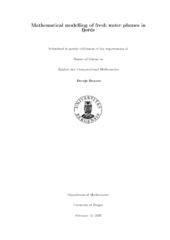| dc.contributor.author | Beyene, Dereje Weldesemayat | |
| dc.date.accessioned | 2020-03-07T03:44:10Z | |
| dc.date.available | 2020-03-07T03:44:10Z | |
| dc.date.issued | 2020-03-07 | |
| dc.date.submitted | 2020-03-06T23:00:08Z | |
| dc.identifier.uri | https://hdl.handle.net/1956/21458 | |
| dc.description.abstract | Nutrients are basic elements for healthier biological process in the ocean.The waters in parts of the fjord like some of the worlds coastal areas doesn’t experience exchange between the coast and nutrient and oxygen rich bottom waters. Due to shallow inlet, replacement of water becomes very limited. Pollution from the aqua-culture industry, has also played a role in low level oxygen at the bottom (Soltveit and Jensen, 2017). The main purpose of this thesis is to show ways on how to improve the conditions of the low quality water by entraining and mixing of the waters from the bottom of the sea. One of the different mechanisms that would help in achieving this, is to discharge fresh waters down to the bottom of the fjord. This can create a movement between the waters so that nutritious rich water from the bottom entrained and the over all water quality improved. To get this, buoyant plume model is an effective mechanism since it can entrain large volume of fresh water and mix it with an ambient fluid (Fischer et al., 1979). A mathematical model has been made for the prediction of spreading and rising of a round buoyant fresh water plume in uniformly stratified stagnant fluid. The model is based on the governing equation of volume, momentum and buoyancy fluxes. The integral equations has been derived in radial and vertical directions using axi-symmetric assumptions. In order to get closure, the basic entrainment assumption has been tested for different values of entertainment constant. The amount of waters entrained from the surrounding in per unit area is of a great interest, since it helps in the design of the over all time needed to transport all the nutrients from the bottom of the water. The maximum vertical distance traveled by the plume is calculated and analyzed for a range of initial parameters when the fresh water hits the linearly stratified fluid. The effects of linear stratification on the plume has also been studied. The model is based on initially round, buoyant plume discharged continuously into stagnant and uniformly stratified water. Mathematical modeling of the plume has been formulated and developed using Matlab ODE 45. | en_US |
| dc.language.iso | eng | |
| dc.publisher | The University of Bergen | en_US |
| dc.rights | Copyright the Author. All rights reserved | |
| dc.subject | stratification | |
| dc.subject | mathematical modeling | |
| dc.subject | buoyant plume | |
| dc.title | Mathematical modeling of fresh water plumes in fjords | |
| dc.type | Master thesis | |
| dc.date.updated | 2020-03-06T23:00:08Z | |
| dc.rights.holder | Copyright the Author. All rights reserved | en_US |
| dc.description.degree | Master's Thesis in Mathematics | en_US |
| dc.description.localcode | MAB399 | |
| dc.description.localcode | MAMN-MAB | |
| dc.subject.nus | 753109 | |
| fs.subjectcode | MAB399 | |
| fs.unitcode | 12-11-0 | |
